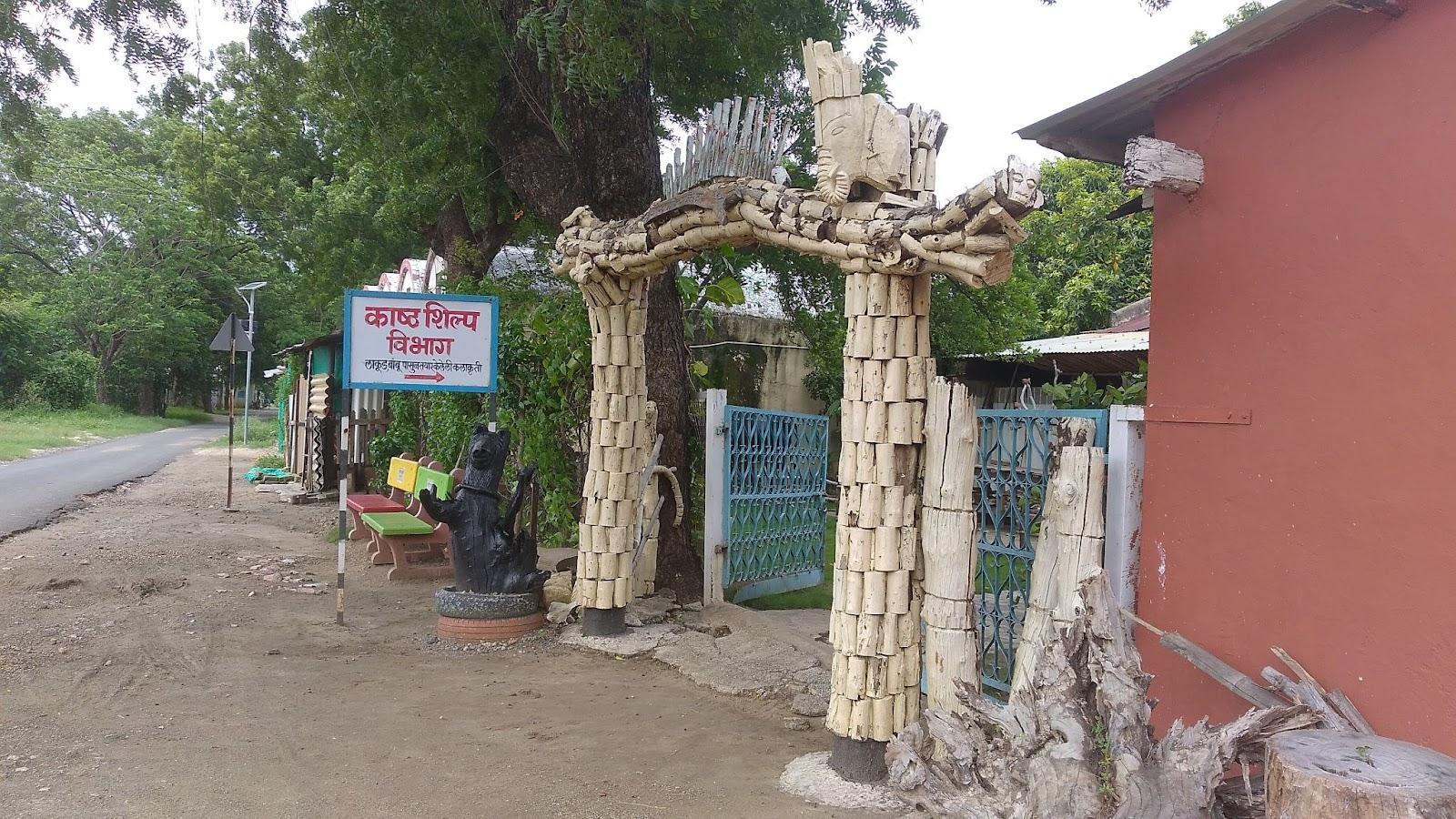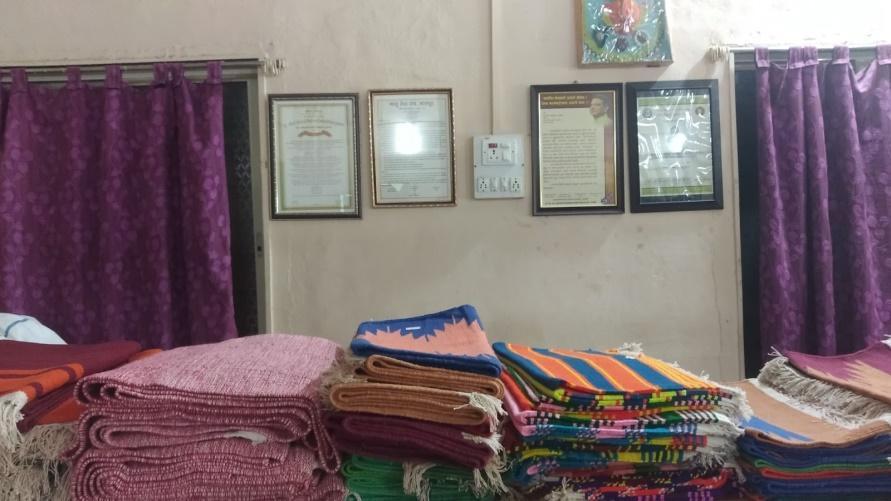CHANDRAPUR
Artforms
Last updated on 21 July 2025. Help us improve the information on this page by clicking on suggest edits or writing to us.
Literary & Performing Arts
Zadipatti
Zadipatti is a form of theatrical performance which is usually performed in the eastern Vidarbha region of Maharashtra, specifically in the districts of Chandrapur, Gondia, Bhandara, and Gadchiroli.
The etymology of this dramatic art form is particularly interesting, they are linked to multiple aspects of the region’s identity. The area is colloquially often regarded as the Jhadi region, a term referring to its dense forests (jhadi meaning “thicket” or “forest”) and rice fields. A language variety called Jhadi is also spoken here, which could have historical ties to the art form.
Another explanation links the name to zadi (rice) and pat (bull race), both integral to the region’s agricultural traditions. Very notably, Zadipatti performances are typically held during the rice harvest or after Diwali, coinciding with Mandai, a festive season known for its bull races and theatrical performances.
Dandar
Dandar is a traditional performance art which is practiced in Chandrapur, during Diwali. It is dedicated to Krishna, referred to as Khodal in the Gondi language, and holds immense significance for the local communities.
![Artists performing the Dandar, a performance artform in Chandrapur.[1]](/media/culture/images/maharashtra/chandrapur/artforms/artists-performing-the-dandar-a-performan_H9KfFZy.jpg)
The performance takes place at night and continues into the early morning, incorporating elements of music, dance, and drama. Traditional musical instruments such as the tabla, harmonium, and khanjiri are usually used during the performance.
Gond Painting
Gond painting is an ancient visual art form that is tied to the Gond community, who have a significant presence in Chandrapur and other parts of central India. This art form is renowned for its intricate patterns and vibrant colors, often depicting themes of their folklore, nature, and daily life.
![A Gond painting illustrating traditional motifs inspired by nature by artist Dhawat Singh.[2]](/media/culture/images/maharashtra/chandrapur/artforms/a-gond-painting-illustrating-traditional-_1oiFrkU.jpg)
A distinguishing feature of Gond painting is the minimal representation of human figures, with a primary focus on nature and depictions of devis and devtas. This emphasis aligns with the themes commonly found in Gond artistic and cultural traditions.
Cultural Programs
Mothi Bhavai
Mothi Bhavai is a traditional festival observed on the last day of the Hindu month of Chaitra (which typically falls between March–April), primarily in the villages of Chandrapur district. As part of the ritual, seven stones are arranged on neem leaves and covered with shades made from neem foliage. Boys perform a dance in front of these stones while onlookers throw water on them. This ceremony is believed to invoke the Devi to bless the region with abundant rainfall.
Mandai
Mandai is an utsav (festival) which is fervently celebrated in the Zadipatti regions after Diwali Padwa (New Year’s Day in the Hindu calendar). Traditionally, it serves as a form of entertainment for farmers and laborers, as this period marks a time of relative leisure after the harvest season when earnings have been collected. Originally, the term Mandai referred to a vegetable market in Vidarbha, but its meaning has expanded over time. Today, it is used to refer to a vibrant event resembling a jatra (fair), where vendors sell vegetables, toys, clothing, and other goods and performances are organized throughout the day and night.
![A performance being staged during a Mandai.[3]](/media/culture/images/maharashtra/chandrapur/artforms/a-performance-being-staged-during-a-manda_eEstZ06.png)
Audiences gather to watch various traditional performances such as Dandar, Zadipatti theatre, and Dance Hungama. Many of these performances draw inspiration from the Ramayan and Mahabharat, but they are adapted to include contemporary themes. Humor and song are integral to these productions, making them both engaging and informative. A particularly notable aspect of the festival is the historic role of Kinnars (Hijra community), who have long been active participants in its performances.
Creative Spaces
Anandwan
Anandwan is a community rehabilitation center founded in 1949 by Dr. Murlidhar Devidas 'Baba' Amte. Established with the aim of providing a dignified life to marginalized individuals through self-reliance, the center works to restore a sense of belonging to those who have experienced societal exclusion through collective efforts.

Among the many spheres through which the people here are empowered is art. Residents of Anandwan engage in various crafts and productive activities that provide both income and fulfill daily needs. These include extracting tree bark to create distinctive wallpaper and crafting items such as clothes, bags, slippers, mats, vases, and chairs from wood. The handmade products crafted by the people here attract both domestic and international visitors who purchase them.


Swaranandwan
Swaranandwan ("Orchestra of the Able-Disabled") is a cultural group founded by Dr. Vikas Amte, son of Baba Amte. The group aims to raise funds for people affected by leprosy, as well as individuals with visual, hearing, speech, and physical impairments in Anandwan.
![The Swaranandwan cultural group performing at an event.[4]](/media/culture/images/maharashtra/chandrapur/artforms/the-swaranandwan-cultural-group-performin_JwP90CH.jpg)
The group features over 100 performers, including people affected by leprosy and those with various physical and mental challenges, who present musical and dance performances. These events serve as both artistic expression and awareness-raising platforms.
Artists
Swagat Thorat
Swagat Thorat is a wildlife photographer, playwright, painter, editor, and director. He is known as the "Braille Man of India" for his contributions to making literature available to visually impaired readers. He founded Sparshdnyan, India’s first registered fortnightly Braille newspaper in Marathi, providing news, literature, and opinion pieces in Braille.
![Swagat Thorat.[5]](/media/culture/images/maharashtra/chandrapur/artforms/swagat-thorat5-b7655748.png)
Recognizing the lack of reading material for visually impaired individuals, Thorat learned Braille and began writing for this community. His work focuses on increasing the availability of Braille publications and promoting inclusive access to literature. In 1997, he directed a Marathi play, Swatantryachi Yashogatha (Glorious Story of Independence), to commemorate India’s 50th Independence Day. The production featured 88 visually impaired artistes from two schools and was recognized by Guinness World Records and the Limca Book of Records for having the largest number of visually impaired performers in a single play. He also produced a live audio drama based on Helen Keller’s biography, further contributing to accessible storytelling for visually impaired audiences.
Anirudhha Wankar
Anirudhha Wankar is a renowned singer and actor in dramas, known for his contributions to the performing arts. He owns a production house in Desaiganj Vadasa and established the Zadipatti Natak schools in the area.
![Anirudhha Wankar.[6]](/media/culture/images/maharashtra/chandrapur/artforms/anirudhha-wankar6-38cdaf75.png)
His song ‘Wadharwara’ has gained significant popularity on YouTube. Anirudhha actively organizes various events related to singing and drama throughout Chandrapur and Nagpur. Additionally, he is personally involved in musical mornings such as ‘Bhim Pahat’ during Bhim Jayanti.
Pralhad Thak
Pralhad Thak is an artist and social worker who has received over 170 awards, including recognition from the Limca Book of Records, India Book of Records, and Golden Book of Records.
He teaches art at a school for the deaf under Baba Amte’s Maharogi Seva Samiti in Anandwan. His work includes large-scale maharangoli designs and paintings of social reformers and freedom fighters, some created using his own blood as a symbolic gesture. He has also established an art gallery in his home to display his works.
Sources
Anandwan. Anandwan: A self-sustaining community.https://anandwan.in/anandvan.html
Ankush Travelling. 2023.पूर्व विदर्भातील मंडई (गाव: बरडकिन्ही) चला बघायला!Youtube.https://youtu.be/uevUIhblKFY?si=pbR0hPbqFTU3…
Archisman Dinda. 2018. Swagat Thorat on why he started India’s first Braille magazine. Gulf News. Accessed 13 March 2025.https://gulfnews.com/general/swagat-thorat-o…
Government of Chandrapur. Culture & Heritage. Government of Maharashtra.https://chanda.nic.in/en/culture-heritage/
Haima Deshpande. 2022. We The People: Literary Torchbearer For The Blind. Outlook India. Accessed 13 March 2025.https://www.outlookindia.com/national/we-the…
Harishchandra Borkar. 2017. “Jhadi.” The Languages of Maharashtra, People’s Linguistic Survey of India. Edited by G. N. Devy and Arun Jakhade. Vol. 17, part 2.
Indian Culture. Zadipatti. Indian Culture.https://indianculture.gov.in/intangible-cult…
Lokmat. 2021. Rakhrangoli paintings painted by Pralhad Thak with his own blood. Lokmat. Accessed 13 March 2025.https://www.lokmat.com/chandrapur/rakhrangol…
Sumita Sarkar. 2012. Swaranandwan to raise funds for Anandwan lepers. Times of India. Accessed 13 March 2025.https://timesofindia.indiatimes.com/city/nas…
TRTI Quest. Gond paintings: A reflection of the gradually evolving rich Gond culture. Aadivasi Vikas Vibhag Maharashtra Shasan.https://trtiquest.wordpress.com/portfolio/go…
World Record Holders Club. Unique artistic records.https://worldrecordholdersclub.com/archives/…
Last updated on 21 July 2025. Help us improve the information on this page by clicking on suggest edits or writing to us.